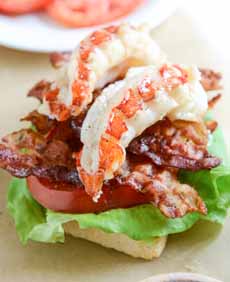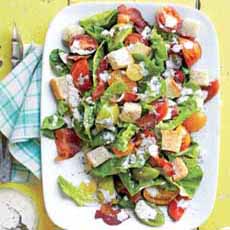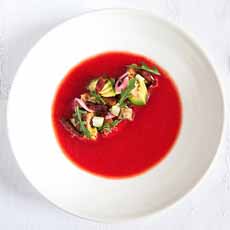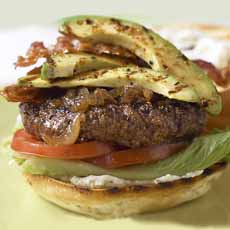The History Of The BLT For National BLT Sandwich Month
|
|
April is National BLT Month; July 22nd is National BLT Day. The bacon, lettuce and tomato sandwich with mayonnaise, often served as a triple-decker sandwich on toast, is one of America’s favorite sandwiches (and a U.K. favorite, too). While toast, bacon and lettuce have been enjoyed at table since Roman times, two of the other ingredients took a bit longer to come together. > The history of the club sandwich is below. Although its ingredients have existed for thousands of years, there is little evidence of BLT sandwich recipes before 1900. The first known mention of a BLT sandwich appears in a 1903 Ladies Home Journal. That same year, the Good Housekeeping Everyday Cook Book featured a recipe for a club sandwich included bacon, lettuce, tomato, mayonnaise and a slice of turkey sandwiched between two slices of bread. According to Merriam‑Webster, the first known print appearance of the acronym BLT is 1950. Historical accounts suggest the abbreviation emerged as diner shorthand during the 1940s. The BLT became popular after World War II due to the rapid expansion of supermarkets, which made its ingredients, especially tomatoes, available year-round. See below for creative modern variations to the classic B.L.T. The oldest of the five ingredients is bread. The art of using yeast to leaven bread was mastered by the ancient Egyptians. Loaves of bread presented more culinary opportunities than flatbreads. Then came lettuce. Lettuce was first cultivated by the ancient Egyptians, who turned it from a weed into a food plant as early as 2680 B.C.E. It was taken to Greece and Rome, and by 50 C.E., many types of lettuce were grown there. > The history of bread. Wild boar meat was cured be smoking, salting and drying since Paleolithic times. (The Paleolithic, also known as the Stone Age, extended from 750,000 B.C.E. or 500 B.C.E. to approximately 8,500 B.C.E. [source]). Pigs were domesticated from wild boar as early as 13,000–12,700 B.C.E. But there was nothing identifiable as modern bacon. The modern bacon we know and love began to appear in the mid-1700s. Previously, the word “bacon” referred to all pork, then the back meat, then all cured pork. British farmers who noticed that certain breeds of pig had much plumper sides, engendered a movement so that “bacon” was finally distinguished as the side of pork, cured with salt. Here are the history of bacon, and the different types of bacon. > The history of bacon. Tomatoes were brought to Europe from the New World at the end of the 16th century. But not as food. The original tomatoes were like yellow cherry tomatoes. Considered poisonous (they’re members of the Nightshade family), they were enjoyed as houseplants. Tomatoes weren’t eaten for two more centuries, and then only because of a famine in Italy in the early 1800s. They arrived in England in the 16th century (see the history of tomatoes). > The history of tomatoes. At the same time, there was no mayo for the BLT. The original mahónnaise sauce was invented in 1756, but it was not until years later that it evolved into what is recognized as modern mayo. The great French chef Marie-Antoine Carême (1784-1833) lightened the original recipe by blending the vegetable oil and egg yolks into an emulsion, creating the mayonnaise that we know today. > The history of mayonnaise. It took John Montagu, Fourth Earl Of Sandwich, to invent the eponymous food in 1762 (history of the sandwich). A marathon gambler, he would not leave the gaming table to eat, so asked for meat and a couple of pieces of bread. He could throw dice with one hand and eat with the other, no knife or fork required. (Sushi was invented for the same reason.) The first sandwiches were gambling food: something easy to eat without utensils. Fancier sandwiches evolved, but it took more than 100 years for someone needed to invent the club sandwich. While tea sandwiches with bacon, lettuce and tomato were served during Victorian times, a search of 19th and early 20th century American and European cookbooks points to the club sandwich as the progenitor of the BLT. No printed record has been found to date, so the where and who remain a matter of culinary debate. The reigning theory points to the Saratoga Club in Saratoga, New York The club sandwich was very popular and spread to other mens’ clubs. A printed recipe appeared for the first time in the 1903 Good Housekeeping Everyday Cook Book. It called for bacon, lettuce, tomato, mayonnaise and a slice of turkey sandwiched between two slices of bread (no one has yet discovered when the third slice of bread was added). So, violà: the club sandwich, a turkey BLT (photo #5), hits menus and cookbooks. When no turkey was desired, the “club sandwich without turkey” became a bacon, lettuce and tomato sandwich—later shortened to BLT. There’s an unsubstantiated story of a man who came home hungry after his family and servants had retired. He searched the pantry for a snack, deciding to make some toast. As he looked in the ice chest for butter for the toast, he found cooked bacon, chicken, a tomato and mayonnaise. He made a sandwich and was so happy with his creation that he mentioned it to friends at his club. They had the kitchen recreate it, and it went onto the menu as the “club sandwich.” The BLT on toast has been recreated with many variations. The most prominent may be the BLTA, bacon, lettuce, tomato and avocado. But why stop there? Create your own signature BLT from these ingredients! Consider: |
|
|
Cocktails Get together a group and assign a different version of BLT to each. Make a whole meal of it…perhaps with chocolate-covered bacon for dessert. Don’t restrict your thinking: A Cobb Salad is a BLT salad with some additions (avocado, blue cheese and chicken). April is National BLT Month and July 22nd is National BLT Day. But also take a look at: CHECK OUT WHAT’S HAPPENING ON OUR HOME PAGE, THENIBBLE.COM.
|
||










